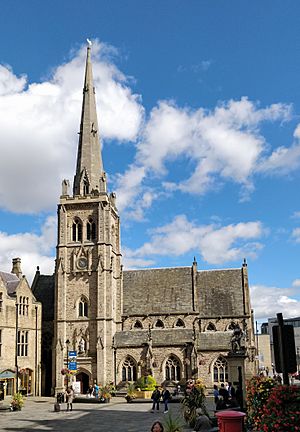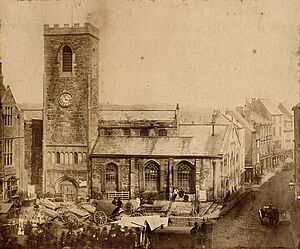St Nicholas Church, Durham facts for kids
Quick facts for kids St Nicholas Church, Durham |
|
|---|---|
| St Nics | |

The church viewed from the marketplace
|
|
| 54°46′39″N 1°34′31″W / 54.77750°N 1.57528°W | |
| Location | Durham, County Durham |
| Country | England |
| Denomination | Church of England |
| Churchmanship | Open Evangelical |
| History | |
| Status | Civic church |
| Dedication | Saint Nicholas |
| Architecture | |
| Functional status | Active |
| Heritage designation | Grade II |
| Architect(s) | James Pigott Pritchett junior |
| Completed | 1858 |
| Specifications | |
| Bells | 6 (1687) |
| Administration | |
| Parish | St Nicholas Durham |
| Deanery | Deanery of Durham |
| Archdeaconry | Archdeaconry of Durham |
| Diocese | Diocese of Durham |
| Province | Province of York |
St Nicholas Church, often called St Nics, is a Church of England church. It is located in Durham in County Durham, England. The church follows the open evangelical tradition within the Church of England.
Contents
History of St Nicholas Church
The First St Nicholas' Church
The first St Nicholas' Church was likely built in the early 12th century. Ranulf Flambard, who was the Prince Bishop of Durham, started it. He cleared an area called Palace Green near the cathedral and his castle. Then, he created the marketplace below the castle. The church of St Nicholas, who is the patron saint of merchants, was built next to it. The first known vicar, Galfrid de Elemer, was recorded in 1133.
This old church had strong walls and a square tower. Part of its north wall was also part of the city walls. It stood next to the old Clayport Gate until that gate was removed in 1791. There were graveyards both in front and behind the church.
Over many years, the building was changed a lot. For example, part of the east end was made shorter to make the road wider. In the 19th century, a market area was built against its south wall. In 1803, people said the church was "very ruinous," meaning it was falling apart. Sir Stephen Glynne, who visited in 1825, said it was a "large structure." He noted that many old parts had been removed. However, he did say the South porch was "good Perpendicular" in style.
Rebuilding in 1858
In 1854, a contest was held to find an architect to fix the church. James Pigott Pritchett junior, a 24-year-old architect from Darlington, won. But when the market area was taken down, they found the church was too damaged to repair. So, Pritchett was hired to design and build a brand new church instead. The vicar at the time, George Townshend Fox, gave £1000 to help pay for the rebuilding. This was a very large sum of money back then.
The old church was taken down in June 1857. Almost all that remains from it are its font, which is a basin used for baptisms, from 1700. Also, its five bells from 1687 are still around. These bells are the oldest set of bells in the whole diocese. The bells were not rung from the 1970s because people worried about the tower's safety. However, bell ringing started again in 2000. These 17th-century bells, plus a sixth bell added in 1889, are now rung often.
— Inscription on the five original bells
Pritchett's new church was designed in the decorated gothic style. It was expected to cost £3,600. The church officially opened with a big ceremony in December 1858. The Illustrated London News newspaper called it "the most beautiful specimen of church architecture in the north of England." The famous expert Nikolaus Pevsner thought it was one of Pritchett's best works. It was the first church in Durham to have a spire, which is a tall, pointed structure on top of the tower. The spire was not in Pritchett's first plan. But Vicar Fox wanted it and paid the £400 cost himself. Today, the church is a Grade II listed building, meaning it is an important historical building.
Changes and Recent Times
George Carey, who later became the Archbishop of Canterbury, was the vicar of St Nicholas from 1975 to 1982. During his time, he led a project to change the church's inside. They removed the pews (long benches) and most of the Victorian features. This made the church more flexible for worship and community activities. Carey wrote a book called The Church in the Marketplace about these changes.
During the COVID-19 pandemic in 2020, the church moved many of its activities online. They offered morning and evening services every Sunday, plus daily prayers. Vicar Arun Arora said that more people attended some online services than had come to in-person events before. The church planned to keep livestreaming its services even after in-person gatherings started again.
Parish and Community
The church's local area, called its parish, is quite small. It covers the area around the Market Place, Claypath, and The Sands. It is surrounded by the parishes of Durham's three other old city churches: St Giles', St Oswald's, and St Margaret's. In the past, many people lived in this parish. However, changes like slum clearance in the 1920s, which involved removing old housing, greatly reduced the number of residents. Even though some new buildings have added a few more people, most of the church's members come from outside its direct parish.
St Nics has many students in its congregation. The Diocese of Durham sees it as a special place. This means its mission is different from other churches in the city center. The church has a long history of following the evangelical tradition. The Church Pastoral Aid Society has supported the church since the mid-19th century.
Helping Others and Outreach
One special part of the redesigned church was the Gateway World Shop. This shop was in the south-east corner of the church and had its own outside entrance. It sold Fair trade goods. Fair trade means that producers in developing countries are paid fairly for their products. This shop showed the church's long support for the fair trade movement. Richard Adams, who started Traidcraft, was a member of this church. The shop closed in February 2023. This was partly because of rising costs and lower profits after the COVID-19 pandemic. Also, fair trade goods became more available in regular supermarkets.
St Nics has a long history of supporting missions overseas. Alfred Tucker, who became the first bishop of Uganda, left his job at St Nics to bring Christianity to Uganda. Today, the church continues this support by giving money to groups like the Church Mission Society, South American Missionary Society, the Bible Society, Spanish Outreach Ministries, and the Diocese of Lesotho.
Notable Clergy Members
Many important people have served at St Nicholas Church:
- Arun Arora, who was the Director of Communications for the Church of England, was vicar from 2017 to 2022. He later became the Bishop of Kirkstall.
- Pete Broadbent, who later became the Bishop of Willesden, worked here in the late 1970s.
- George Carey, who later became the Archbishop of Canterbury, was vicar from 1975 to 1982.
- David V. Day, a former Principal of St John's College, Durham, was a minister from 1999 to 2007. He is still part of the ministry team.
- Alistair Magowan, who later became the Bishop of Ludlow, was a curate here from 1984 to 1989.
- George Marchant, who later became the Archdeacon of Auckland, was vicar from 1954 to 1974.
- Maeve Sherlock, Baroness Sherlock, became a curate here in 2018 and an Associate Minister in 2022.
- Alfred Tucker, who later became the Bishop of Eastern Equatorial Africa, worked here in the 1880s.
- John Wenham, a Bible scholar, was vicar from 1948 to 1953.
- Frank White, who later became the Bishop of Brixworth, worked here in the 1980s.





